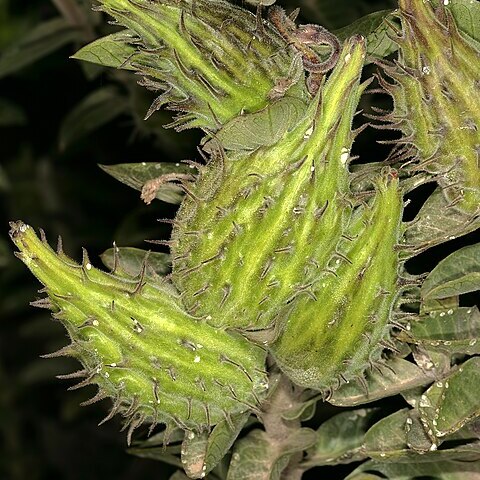Perennial herb or shrub, 0.7-1.2 m high. Stems erect, stout. Leaves opposite, coriaceous, ovate or oblong, 37-62 x 10-29 mm, base truncate, midrib stout, secondary veins pronounced beneath. Inflorescences extra-axillary, terminally clustered, 15-30-flowered; peduncle 5-17 mm long. Flowers cream-coloured to white. Corolla reflexed; lobes ovate, 5-7 x 3-4 mm. Staminal column inconspicuously stipitate. Corona white tinged purple; lobes saccate, somewhat fleshy, central sinus cavity 2-3 x 1-2 mm, upper proximal end level with style-stigma-head, upper margin truncate. Flowering time Apr.-July? Follicles: stalks twisted, solitary, ± erect, ovoid, slightly inflated, beak short.
Erect, perennial shrub to 1 m tall. Leaves sessile or with petiole to 4 mm long; lamina elliptic or ovate to lanceolate-ovate, to 6 cm long, to 2.8 cm wide, cuneate at base, acute; secondary veins 8–10 each side of midrib; colleters absent. Inflorescence umbelliform or with 1 or 2 fascicles. Flowers 5–6 mm long, 9–11 mm diam.; pedicels 17–20 mm long. Corolla purple; lobes lanceolate-ovate, 5–6 mm long. Staminal corona 3.5–4 mm long; each lobe 2.8–3.2 mm long, 1.8–2 mm wide. Follicles ovoid at maturity, 5–6 cm long, 1.5–2.5 cm wide, acuminate, with sparse, soft teeth 5–6 mm long scattered over surface.
Shrub, up to 1 m tall, stems erect, branching mostly from base, velvety, sap milky. Leaves oblong to elliptic, mostly sessile, 25-50 x 12-30 mm, leathery, nearly glabrous. Flowers 12-30, in extra-axillary umbels, on peduncles 5-20 mm long, pedicels 18-25 mm long. Corolla white, faintly suffused with pink. Corona yellowish white, without a stipe, flat-topped and flush with style head, without a horn in cavity. Fruit ovoid, 40-70 x 18-30 mm, beaked, covered with soft bristles.
Rigid, hairy shrub to 1.5 m; sap milky. Leaves opposite, oblong-lanceolate to elliptic, usually rounded at base, leathery. Flowers cream-coloured. Fruits inflated, ovoid-acute.

